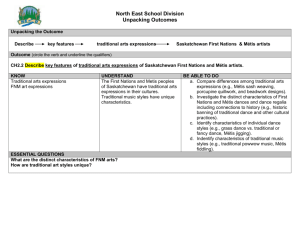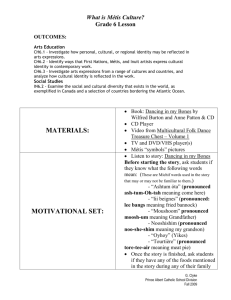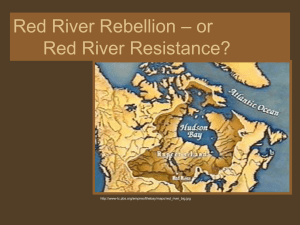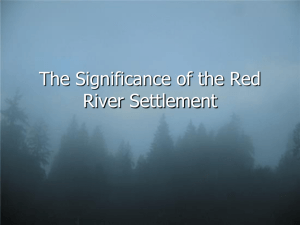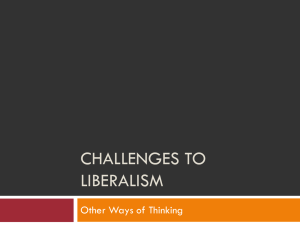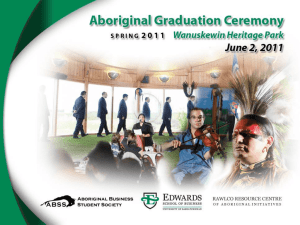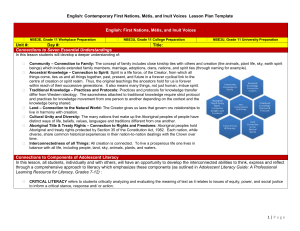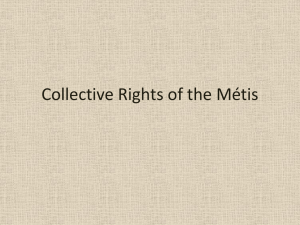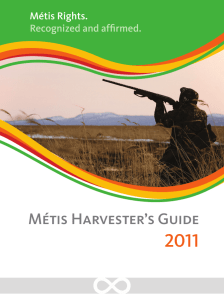Lesson
advertisement
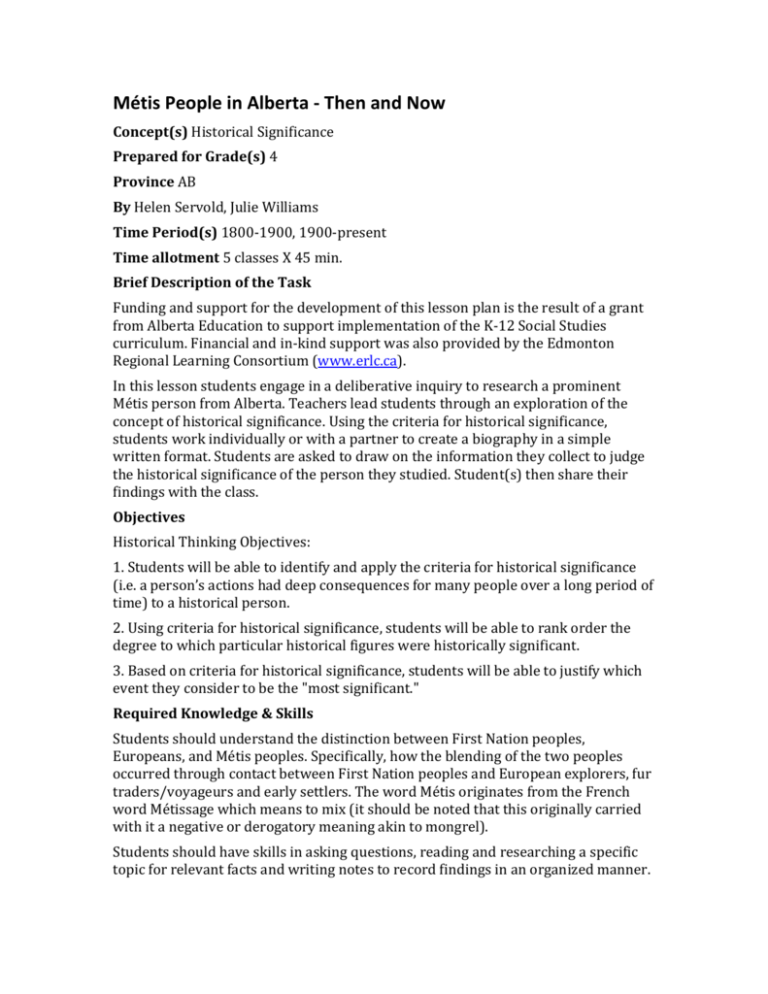
Métis People in Alberta - Then and Now Concept(s) Historical Significance Prepared for Grade(s) 4 Province AB By Helen Servold, Julie Williams Time Period(s) 1800-1900, 1900-present Time allotment 5 classes X 45 min. Brief Description of the Task Funding and support for the development of this lesson plan is the result of a grant from Alberta Education to support implementation of the K-12 Social Studies curriculum. Financial and in-kind support was also provided by the Edmonton Regional Learning Consortium (www.erlc.ca). In this lesson students engage in a deliberative inquiry to research a prominent Métis person from Alberta. Teachers lead students through an exploration of the concept of historical significance. Using the criteria for historical significance, students work individually or with a partner to create a biography in a simple written format. Students are asked to draw on the information they collect to judge the historical significance of the person they studied. Student(s) then share their findings with the class. Objectives Historical Thinking Objectives: 1. Students will be able to identify and apply the criteria for historical significance (i.e. a person’s actions had deep consequences for many people over a long period of time) to a historical person. 2. Using criteria for historical significance, students will be able to rank order the degree to which particular historical figures were historically significant. 3. Based on criteria for historical significance, students will be able to justify which event they consider to be the "most significant." Required Knowledge & Skills Students should understand the distinction between First Nation peoples, Europeans, and Métis peoples. Specifically, how the blending of the two peoples occurred through contact between First Nation peoples and European explorers, fur traders/voyageurs and early settlers. The word Métis originates from the French word Métissage which means to mix (it should be noted that this originally carried with it a negative or derogatory meaning akin to mongrel). Students should have skills in asking questions, reading and researching a specific topic for relevant facts and writing notes to record findings in an organized manner. Additionally, students should have familiarity with the criteria for historical significance. Detailed Instructions Part A 1. Provide background information about First Nation peoples, the introduction of Europeans to the West, and the new Métis Nation. This information can be obtained in student text books approved for use in Alberta schools (see editions by either Pearson or Nelson). You may also want to use alternate resources like the Métis Crossing website to provide students with relevant background knowledge (see ATT 1 — Reference List — for websites and a list of Métis people for study). 2. Explain to students that the purpose of this unit is to help them gain some of the tools historians use to decide which figures in the past should be seen as historically significant. Clarify to students that the past is everything that ever happened to anyone anywhere. There is too much that has happened in the past to remember it all. Therefore, historians must choose which events, people, and developments are worth remembering. This is where historical significance comes in; these criteria help us decide which people, in this case, are the most important. Explain to students that the criteria historians use to make this judgment are as follows. (i) Resulted in change · The person’s actions had deep consequences for many people · The person’s actions affected many people · The consequences of this person’s actions lasted for a long period of time (ii) Revealing -- The person sheds light on an aspect of the past; helps us understand the past in a new way To help students see connections between the criteria for historical significance and their own life, ask students which people are significant to them. Emphasize the need to make this judgment using the criteria for historical significance. Visit the Benchmarks of Historical Thinking website for strategies to help students make these connections and better understand the concept of historical significance (http://historybenchmarks.ca). 3. Once students have some background knowledge and a basic understanding of the concept of historical significance, reinforce the concept using Louis Riel as a prominent and well known Métis example. Explain that Louis Riel was a significant Métis leader who worked hard for the rights of the Métis people as a Nation. Using Louis Riel as the class example, model the research process students will undertake based on the criteria for historical significance. Drawing on the websites found in the Reference List (see attachment), explore some of the reasons why he might be deemed a significant historical figure. One of these might be that after seeing land traditionally belonging to the Métis people taken over by British and Scottish settlers he led a resistance against this incursion. One of the long-term consequences of his actions was his execution. 4. Once you have worked through an example with students, distribute a list of prominent Métis people from Alberta (see ATT 1 — Resource List) and assign or invite students to select a person to study. Then distribute copies of ATT 2 — Métis People in Alberta: Biography. This worksheet helps students to record information as they complete their research. 5. Book computer time for students to conduct their research using the websites provided (see ATT 1 — Reference List). Some students may need to conduct additional work at home. You may wish to ask students to save extraneous information for display or sharing after this initial assignment is complete. The goal of this lesson is to stay on topic and complete it within a five day/lesson time frame. Additionally you may want to include Language Arts objectives at your discretion. Part B Allow the students an opportunity to share with the class what they have learned about the Métis person they researched. Guide the class discussion towards a focus on what is historically significant (resulting in change, revealing, relevant) about their figure (e.g. positive/negative contributions, development of new communities, creation of institutions and organizations, enrichment of the culture, improvement of the quality of life of Albertans, and inspiration provided to others). Students should be directed to specifically use the criteria for historical significance to explain why their person is significant and which contributions and actions were most important in this regard. After sharing their knowledge on a Métis person with the class, ask students to use the criteria for historical significance to decide which figure’s contribution should be considered the most significant. Using the student handout (Attachment 2), ask students to provide an explanation as to why they made this judgement. Extension Activity As part of a culminating activity you could ask students to offer their thoughts in regard to the Métis Nation in the early years and who they are now in the present. The range of persons studied will be the source of their knowledge and opinions. Using a Venn Diagram (see Attachment 3 Venn Diagram Métis Past and Present), ask students to compare the Métis of the 1600's to those in the present. In this way students can identify how this community has changed while also preserving their culture to develop and retain their identity as a group within Alberta. Outcomes Alberta Social Studies Learning Outcomes: 4.2.2 The student will assess, critically, how the cultural and linguistic heritage and diversity of Alberta has evolved over time by exploring and reflecting upon the following questions and issues: 4.2.2.6 How did the Métis Nation and Métis Settlements contribute to Alberta's identity (i.e. language, accomplishments)? Dimensions of Thinking 4.S.1 develop skills of critical and creative thinking 4.S.1.3 re-evaluate opinions to broaden understanding of a topic or an issue 4.S.1.5 seek responses to inquiries from various authorities through electronic media 4.S.2 develop skills of historical thinking 4.S.2.1 use photographs and interviews to make meaning of historical information
